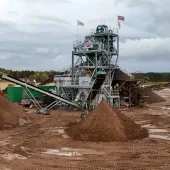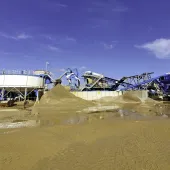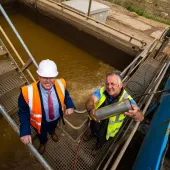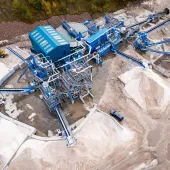Fifteenth anniversary of TWS bucket-wheel range

Terex Washing Systems celebrate 15 years of their Finesmaster BW sand plant range
THIS year marks the 15th anniversary of the Terex Washing Systems (TWS) Finesmaster (FM) bucket-wheel (BW) range, which has become a popular solution for sand producers seeking a reliable, efficient, durable sand plant offering longevity, reliability and ease of maintenance. Although sand producers have worked with bucket-wheel technology for decades, with the added technology of the cyclone system, they are able to reap the benefits of even greater material recovery.
The particular benefit of the bucket-wheel system is its ability to significantly reduce the amount of coarse material coming into contact with the pump and cyclone, as it is fed directly from the bucket wheel to the dewatering screen; only the fine sand comes into contact with the rubber-lined parts of the pump and cyclone. This benefits the customer by reducing wear costs, power consumption and, ultimately, processing costs.
TWS applications specialist Justin Donnelly, who played an integral role in the development of the FM BW range, said: ‘When we looked at how we could produce two grades of material in a practical and economical way without adding a second pump and larger cyclones to the Finesmaster we turned to the tried and tested method of the bucket wheel.
‘Bucket wheels are typically operated in the range of 0.5 to 1.3 rev/min via a planetary drive. This slow speed coupled with the robust materials of construction ensure that the connected power requirements and maintenance costs are a fraction of those associated with fitting a second pump. Overall, no other technology compares with the long-term, low-cost operation of the FM BW range.’
The increasing lack of sand reserves was the driving force behind the demand for the plant. TWS global distributors and customers were demanding a system that would allow them to capture more sand and eliminate losses to tailing ponds, while some customers were seeking a way of processing more challenging materials with higher percentages of silt.
Quarry owners also wanted to produce a drier product which could be loaded directly off the belt on to a lorry, reducing the handling process. A number of ideas were proposed by the research and development team at the time, but the concept of combining bucket wheels, cyclones and a dewatering screen on one chassis proved to be the most effective solution.
TWS have recently applied a number of modifications to the plant to further enhance its capabilities and effectiveness, creating an option whereby four cyclones are fitted, giving the unit the ability to capture fine material down to 38 microns. This is proving very popular in manufactured sand applications where fines down to 38 microns can be used in concrete and mortar sands. In addition, the dewatering screen has been developed to produce more energy and greater dewatering capability, while serviceability and access have also been improved with galvanized access stairs and platforms now fitted as standard.
TWS applications team lead Garry Stewart commented: ‘The FM BW range continues to be one of key sand plant solutions in many regions around the globe. This is mainly due to the bucket wheels performing up to 90% of the work, which ultimately lessens the load and wear on the rubber-lined pump and cyclones.
‘Manufactured sand applications are becoming more and more popular with our customers as natural sand and gravels reserves are being depleted. The FM BW, which has proven effective time and time again, is the plant we recommend for these specific types of applications.
‘The plant’s ability to produce two sands by means of an efficient and simple process is a major benefit for many of our customers who want to produce both mortar and concrete sands. The FM BW units are suitable for a wide variety of applications and are available in a range of capacities, including 60, 120 (pictured) and 200 tonnes/h models, as well as 120 and 200 Super Fines (SF) models.’









